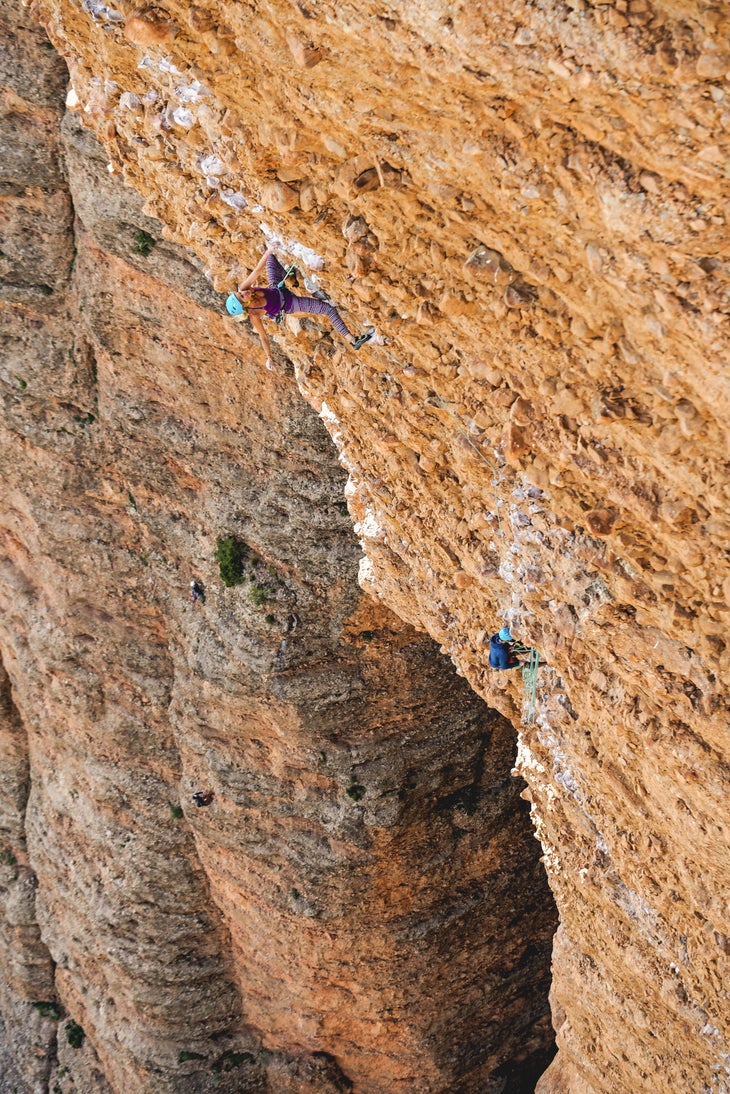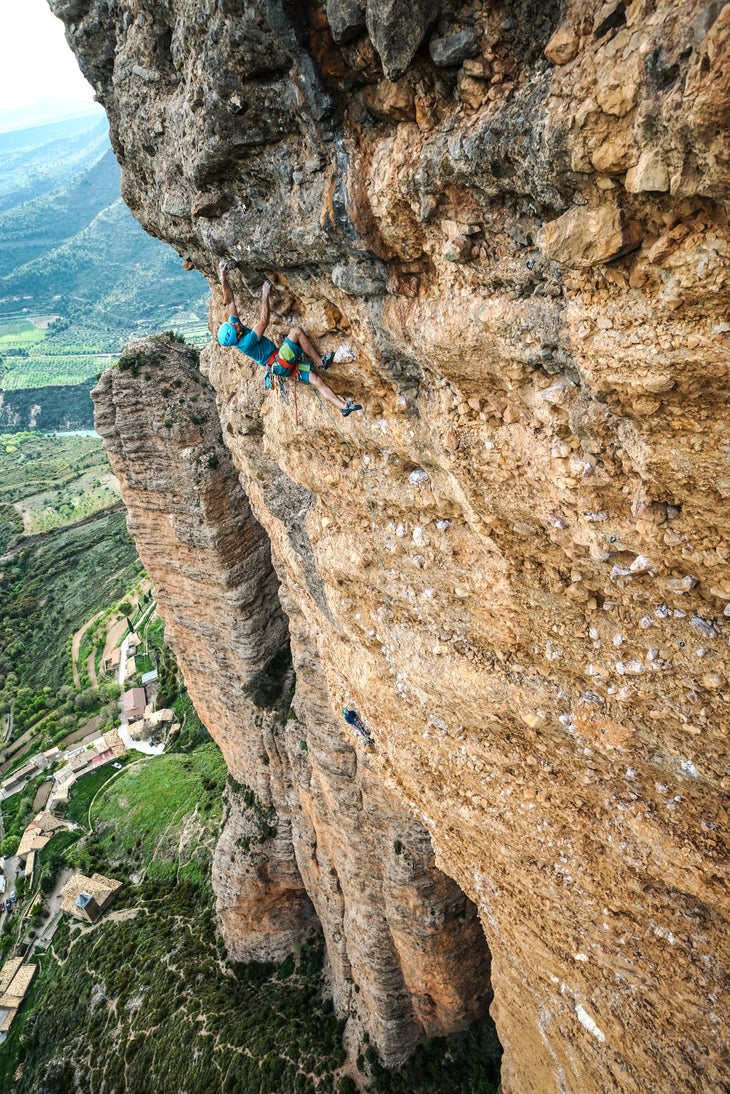Heading out the door? Read this article on the new Outside+ app available now on iOS devices for members! Download the app.
Tucked cozy in bed, my girlfriend, Kim, and I peered over our billowy white covers and out the window of our third-floor Airbnb. Here in tiny Riglos (pop: 250) in Huesca province in Northern Spain, we were within a stone’s throw of the mighty conglomerate towers—Los Mallos de Riglos (“the Mallets of Riglos”)—that soar above town. Perfectly framed by the window, tiny climbers inched up the protruding cobbles of the 1,000-foot monolith El Pison, the dominating tower of the half-mile-wide massif, which is home to some 300 routes from 5.6 to 5.12+.

The springtime weather outside was cold, dark, and cloudy. Worn and sunburned from our own long, harrowing adventure on the “moderate” Mosquitoes, an eight-pitch 5.10d on the radically overhanging Visera formation that we’d climbed in the blazing sun the day prior, we were content just to snuggle, listen to the jingling of goat bells, and watch the morning climbing show.

There were parties on most of the big routes—climbs we were now well familiar with after several days of scrutinizing the guidebook: Oriental, Chopper, Tucan, El Puro. But we were most interested in a pair climbing the tenth and final pitch of Carnivalada (5.12b), a route that had caught our eye for its big initial overhang and bold path directly up El Pison. The leader had made it safely to the summit belay, her rope trailing down the final black water groove before dipping below a huge, overhanging pansa (belly) and then down to her partner. As the second started up, raindrops began falling, hastening him to the base of the overhang. We checked our guidebook and learned that this final pansa was 5.11 and notoriously powerful—a guardian of the summit after 1,000 feet of relentless vertical and overhanging cobble climbing.
The second paused, perhaps to rest or to wait out the intensifying rain. Behind the cliff, visible to us but not the climbers, black clouds piled forward; lightning blazed in the distance while thunder rolled into the canyons like tumbling boulders. As if watching a scary movie, Kim and I urged the climber to hurry. The storm had come quickly, and soon the water groove was a trickling stream. By the time the second started out the overhang, the stream was a small waterfall. As the climber struggled to move past the bulging crux, the water pummeled him against the rock.

No matter where on the four corners of earth, conglomerate big-wall areas seem to share a specific, if unspoken, set of rules: Routes are established ground-up, suspect holds are left in place, and bolts are well-spaced. A climber embarking on a massive tower in Meteora, Greece, would be well-served to have apprenticed on the ancient lava flows of Pinnacles, California, or on the lofty spires of Montserrat, Spain. All of these areas are becoming safer with time, as climbers clean the rock the old-fashioned way—by breaking loose cobbles (some as small as BBs and some as large as sprinter vans) and scrubbing off dirt over the course of countless ascents.
The tan walls of Riglos are no exception. The routes lure you in with easy approaches and shining bolts—but be warned, climbing originated as a blood sport here, and there is no guarantee of safety on these old-school “sport” routes, where runouts can stretch up to 30 feet and where first ascentionists sometimes paid for their aspirations with their lives.

Consider one of Riglos’s former last great problems, the 400-foot spire El Puro (“The Cigar”), which splinters off El Pison and wasn’t ascended until 1953. Beginning in the 1940s, several parties began a protracted battle to conquer El Puro that involved at least five failed attempts—two ending in death. In one instance, Mariano Cored was killed when he fell unprotected to the ground from 100 feet up when a hold broke as he attempted to bypass a crux by standing on his partner’s shoulders. Another climber, Victor Carilla, was killed in 1950 when his rope broke in a fall. Reportedly, his protection consisted entirely of old, in situ gear and slung bushes.
Nowadays, you’ll find only traces of those brutal days, usually in the form of vintage protection. The knob-covered walls range from slabby to radically overhanging, some solid and well-traveled, some loose and obscure. Most of the routes continue to the tops of the formations, though you can certainly “crag” by climbing the first pitches only. While you’ll occasionally need to place your own protection, most of the gear is fixed. These days, bomber bolts are the norm, but if you stray from the trade routes you’ll find all manner of old, bizarrely fashioned, jerry-rigged gear (what in the hell are those wooden expansion stakes?). On most routes, at some point, you will find yourself pumped and runout. If you’re fit, good—you’ll have the time and energy to give a testing knock on suspect holds or tug on iffy gear. If you aren’t, just cross your fingers, pretend it’s all bomber, and keep on motoring.
Eventually, despite the drama unfolding outside our window, Kim and I fell back asleep. Mosquitoes, with its polished cobbles, runouts, and sunny exposure, had worn us out. When we woke up, the clouds had disappeared, birds were chirping, and the climbers were safely on top, drying in the hot Spanish sun. It all felt appropriate in this ancient land of monstrous spires, full of scary fairy tales that mostly end well.




Riglos Logistics
Season
Climbing is possible all year, though in winter you’ll need calm, sunny days, and in summer you’ll chase shade.
Getting there
Fly to Barcelona and rent a car. The drive is about 3.5 hours.
Lodging
A number of Airbnbs are available in the village, though Casa Fiesta Riglos is the favorite among climbers. Rooms are also available at the bar in town, or you can van camp in the main village parking lot.
Rest days
The nearby town of Murillo de Gallego offers a host of recreational opportunities along the Gallego River as well as a spa hotel with a dreamy hot-pool complex. Also nearby, take a self-guided tour of the eleventh-century Castillo de Loarre, a castle/abbey that is a wondrous trip back in time.

Jim Thornburg has been eking out a living as a climbing photographer for the past 30 years. He remains stubbornly committed to the craft. His coffee-table book, Stone Mountains, is available at jimthornburg.com.